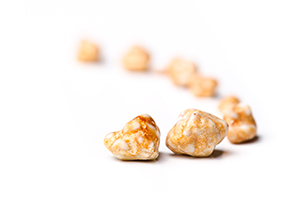| By Dr. Ronald Hoffman
allstone disease is one of the most common and costly of all digestive diseases. It is estimated that 10-20% of all US adults have gallstones. Each year, around 500,000 people develop symptoms or complications necessitating cholecystectomy, and approximately 10,000 people die annually from complications of gallstones.

Excess dietary fat is the culprit in gall bladder disease. This a shibboleth that needs to be put to rest. While it’s true that dietary fat causes the gall bladder to contract, causing pain if you already have gallstones, studies don’t support the notion that a high-fat diet causes gallstones, especially if carbs are limited.
In fact, there’s a high-concordance between fatty liver, metabolic syndrome/insulin resistance, obesity and gall bladder problems. All these are now recognized to be more closely associated with excess dietary carbohydrates, not fats.
A recent study entitled “Dietary carbohydrates and glycemic load and the incidence of symptomatic gall stone disease in men” concludes that “Our findings suggest that a high intake of carbohydrate, glycemic load, and glycemic index increases the risk of symptomatic gallstone disease in men. These results add to the concern that low fat high carbohydrate diets may not be an optimal dietary recommendation [italics added].”
Why does a high-carb diet contribute to gall bladder problems? While it’s true that gallstones are largely composed of cholesterol, a diet rich in refined carbohydrates causes the liver to generate a type of bad cholesterol that is more likely to create stones. Additionally, any diet pattern that promotes overweight, insulin resistance and Type 2 Diabetes hikes the risk for gall bladder disease. It’s even been suggested that having gallstones predicts a higher risk of dying earlier—not due to the danger the gallstones pose, but because of the accompanying cardio-metabolic risks.
Gall bladder disease is rare in non-whites. We were taught the “4 Fs” in medical school: The typical gall bladder sufferer is fat, fair, female and fertile (the latter has to do with the potential for estrogen to promote gallstones). But gall bladder disease, while less common in African Americans, is rampant in Hispanics and persons of Native American ancestry. Interestingly, over 80 percent of the Pima Indians of southern Arizona develop gallstones by age 35
Gallstones are mostly a hereditary problem. While approximately 30 percent of risk for gallstones is inherited, gall bladder problems are mostly a lifestyle disease, preventable via measures that I’ll discuss in an upcoming Intelligent Medicine newsletter article.
The gall bladder is a useless and dangerous organ and should be removed at the slightest sign of trouble, or if an imaging study reveals the presence of stones. While the prevalence of gallstones is high, and their presence can be life-threatening, a high percentage of the population is walking around with asymptomatic stones and are never the worse for it.
After a gall bladder attack, confirmed by evidence of the presence of stones, it’s imperative to have your gallbladder taken out immediately. Or to paraphrase the Bible: “If thine gall bladder offend thee, pluck it out!” The decision to have surgery depends on several factors. “Elective” cholecystectomy, as gall bladder surgery is called when a patient’s symptoms have subsided and it’s decided to remove the gall bladder for preventive reasons, is based on several criteria: If stones are bigger than a certain size; if a “HIDA” scan shows the gall bladder is not emptying properly; if a patient is diabetic and might be high risk for subsequent infection; if a gall bladder polyp bigger than a certain size is spotted, raising suspicion of cancer; if the gall bladder is calcified (“porcelain gall bladder”); if a patient has sickle cell disease; if a gall bladder attack triggers pancreatitis; or if a patient has a very infected gall bladder accompanied by fever or a high white blood cell count. Because of the ease of surgery these days, it’s sometimes a judgement call whether to operate to head off future attacks that may occur when the patient is older and a less suitable surgical candidate.
After undertaking some of the measures I’ll outline in a future newsletter article, many first-time gall bladder sufferers dodge further attacks. Of course, repeated bouts of gall bladder pain call for removal.
Don’t yield to the temptation to get gall bladder surgery, because the incidence of “post-cholecystectomy syndrome” is as high as 50%: Post-cholecystectomy syndrome occurs when patients have their gall bladders out and continue to have symptoms. The cause is not identifiable in every case. While sometimes a stone gets lodged somewhere else in the biliary tract, I suspect that the occasional failure of gall bladder surgery to alleviate symptoms of pain, bloating, and indigestion is that another problem was overlooked—like SIBO (small intestine bacterial overgrowth), food intolerance, or hydrochloric acid or pancreatic enzyme deficiency. In any case, alarmist websites exaggerate the prevalence of post cholecystectomy syndrome, which is actually more like 5 to 10%.
 Patients over 70 are at high risk of dying from gall bladder surgery, so it should be avoided if at all possible in elderly patients. On February 22, 1987, famed pop-artist Andy Warhol succumbed to complications of gall bladder surgery at the age of 58. But this occurred prior to the advent of laparoscopic cholecystectomy, which has minimized the dangers of gall bladder surgery. Additionally, Warhol had delayed gall bladder surgery until he suffered a serious infection and he was weakened after taking several bullets in a previous assassination attempt, was anemic, and probably malnourished. The latest statistics show that death from elective gall bladder surgery is as low as 0.15%
Patients over 70 are at high risk of dying from gall bladder surgery, so it should be avoided if at all possible in elderly patients. On February 22, 1987, famed pop-artist Andy Warhol succumbed to complications of gall bladder surgery at the age of 58. But this occurred prior to the advent of laparoscopic cholecystectomy, which has minimized the dangers of gall bladder surgery. Additionally, Warhol had delayed gall bladder surgery until he suffered a serious infection and he was weakened after taking several bullets in a previous assassination attempt, was anemic, and probably malnourished. The latest statistics show that death from elective gall bladder surgery is as low as 0.15%
Whereas age used to be a contraindication to surgery, improved surgical and anesthesia techniques now enable even patients well into their 80s and 90s to breeze through gall bladder operations. Severe heart and lung disease sometimes preclude surgery, but most older patients with gallstones are considered eligible.
After you have your gall bladder removed, you’ll malabsorb fat, and therefore you’ll need to follow a low-fat diet forever. This line is parroted endlessly on popular websites, but, even after exhaustive research, I could find no evidence that people become fat-intolerant after cholecystectomy. In fact, one of the few articles on the subject, a paper dating back to 1964, states that “It may be assumed that removal of the gall bladder does not influence the absorption of butter fat and olive oil, and that the evacuation of the gall bladder is not essential for the absorption of these types of fat in man.”
This makes sense because the gall bladder does not make bile, it only stores it. When your gall bladder is missing, instead of releasing stored bile to meet the occasional demands of a meal, bile is released continuously. Enough bile is usually secreted to digest fatty meals. Humans are among few animal species to even have a gall bladder.
After you’ve had your gall bladder taken out, you’ll need to take pancreatic enzymes and bile supplements forever. Again, there is no evidence that additional digestive support is required even after cholecystectomy.
People without gallbladders frequently suffer from fat-soluble vitamin and essential fatty acid deficiency, so should be taking (emulsified) A, D, E, and K, and Omega 3 supplements forever. I searched in vain for references to support the notion that, without normal bile secretion, individuals suffer from critical nutrient deficiencies. They just weren’t there. On the contrary, many people gain weight after gall bladder surgery, perhaps because the “brake” that gall bladder colic applies to overeating has been removed.
“Gall bladder flushes” are effective at removing gallstones. This is among the most controversial propositions in gall bladder disease lore. Many books, magazine articles and websites extol the benefits of the “gall bladder flush” which is said to expel stones from the gall bladder. Enthusiastic users report numerous greenish “stones” appearing in their stool.
Typically, users are encouraged to fast while drinking apple juice and/or herbal tea, followed by a “flush” consisting of olive oil and lemon juice.
But a 2005 analysis in Lancet revealed that the composition of these so-called “stones” in no way resembled that of true gallstones (bile salts, cholesterol, and phospholipids), and in fact consisted only of greenish, congealed olive oil. Potassium in the lemon juice creates a kind of soap via kitchen chemistry, making the globules appear to stick together with a semi-solid consistency. While not effective in passing gallstones, there’s the potential risk that a high-fat flush of olive oil will trigger gall bladder contraction, precipitating a painful gall bladder attack.
Stones can easily be dissolved with prescription or herbal medicines. Until the advent of safer surgical techniques in the 90s, it was thought advisable to attempt to dissolve gallstones prior to resorting to definitive removal. Medical therapy was undertaken with Urso- and Chenodiol, but it was found to only be successful for radiolucent gallstones—a less common kind, consisting only of cholesterol. This technique is rarely used today.
Additionally, a myriad of gallstone remedies can be found on the web, each purporting to dissolve stones. The only formula for which evidence exists—albeit equivocal—is Rowachol, a European formula not sold in the U.S. A 1979 study showed gallstone dissolution in 7 patients, but subsequent research is scant.
In a future installment, I’ll enumerate ways that you can keep your gall bladder healthy, and avoid surgery.
Source

